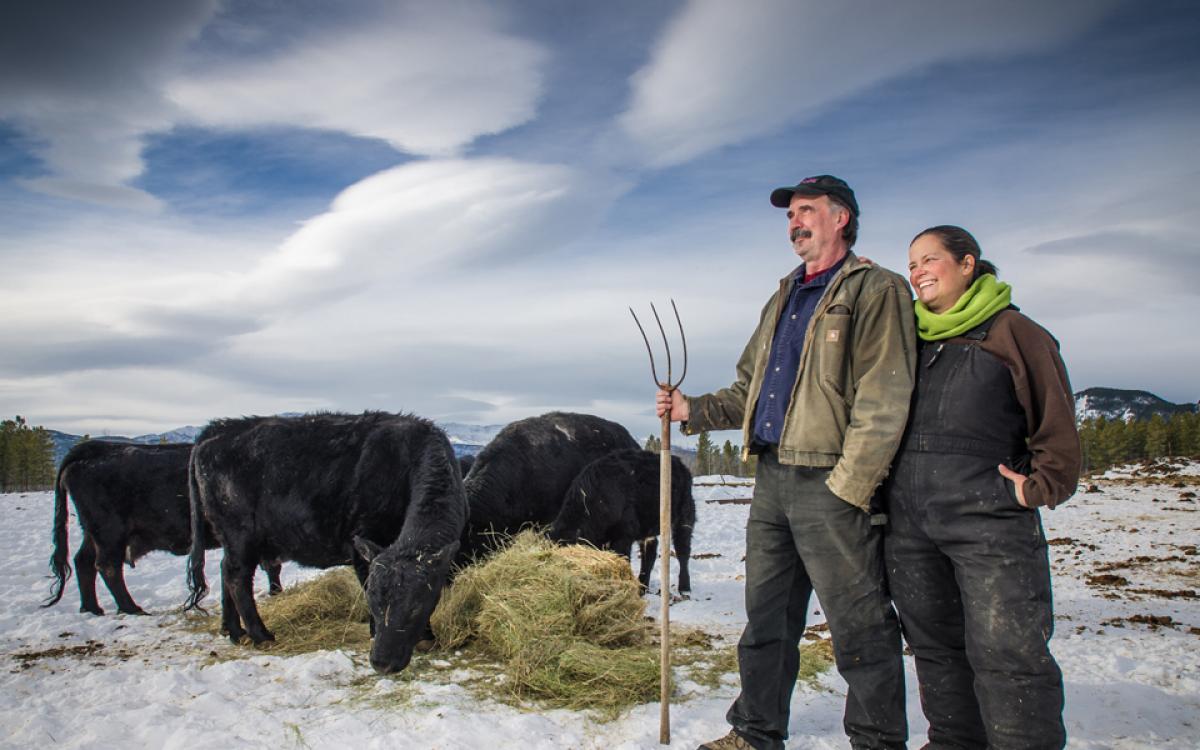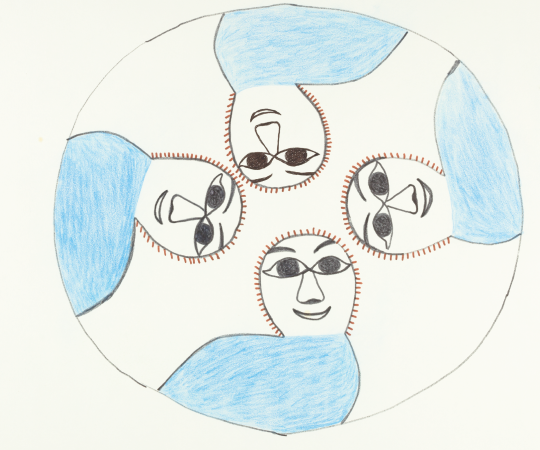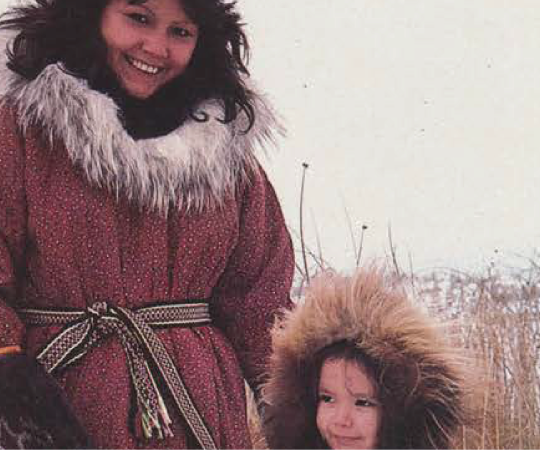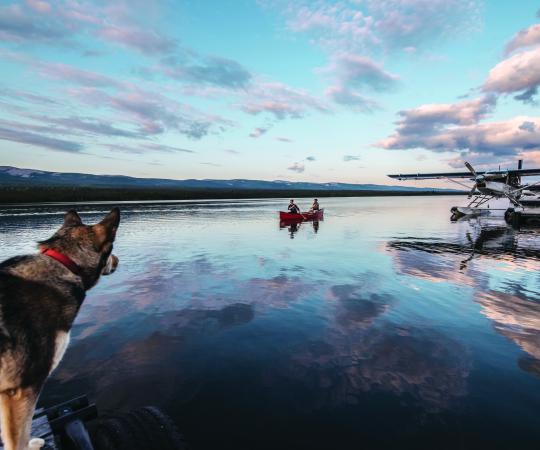“There weren’t no farmers in Rankin Inlet in 1972, I’ll tell ya.”
John Todd is a former NWT finance minister, and was Rankin’s manager at the time. He’s had about as illustrious a career as you can have in Northern politics and business. But he was no farmer.
Rankin’s nickel mine had shut down and a heavily subsidized fish cannery took its place. Arctic char and trout pulled from Hudson Bay were gutted, filleted, smoked, canned and sent south. But the fish guts stayed—and they started piling up.
It was then that an idea of how to put those guts to use was floated around a table comprising many of Rankin’s most entrepreneurial minded. It was a proposal so inconceivable that it could only have gained traction under the doubt-numbing influence of alcohol. Someone knew a guy in Brandon, Manitoba who could get them some chickens—200, to be exact. They would raise the poultry on fish guts. There were lots of people in town without jobs, so the eggs would go to those in need. And what the hell, they’d raise pigs too.
More improbably, the plan survived the next morning’s headaches. “It wasn’t like we thought up any long business plans or stuff like that,” says Todd. “It was all done on a whim.”
Once they figured out that the hens needed laying mash because they weren’t producing eggs while only eating fish guts, the bounty was celebrated. Guys took turns walking down to the few shacks they’d converted into coops, feeding the birds and collecting and distributing the eggs around town. But after a few years of this, the volunteers got burnt out. The chickens were butchered.
The pig project didn’t fare much better. But it ended with a bang. “They made a hell of a noise,” says Todd, and over time, that apparently rankled some in town. One night, a man got drunk and shot them all. Because the pigs had been eating fish guts, when they were butchered and passed around town “they were all ending up in the garbage bins because they reeked of fish,” says Todd. “You had lots of dead pigs sitting in 45-gallon drums.”
It was part experiment, part excuse to plot, scheme and drink beers with buddies, says Todd. And though it was well intentioned, they knew it probably wasn’t going to work out because they didn’t know what they were doing.
It’s been more than 40 years and no agriculture project at that scale has been attempted in Nunavut since. And why should one be? It’s a fool’s errand. You surely can’t grow food, let alone raise livestock, in the cold, dark, barren North. Can you?
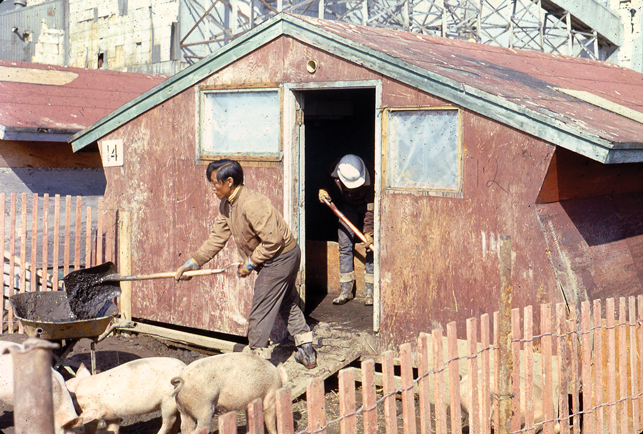
IT’S ONLY BEEN in the last 100 years or so that Northerners have become dependant on complex supply chains and southern producers for their food. This system was gradually created as the federal government imposed settlements on nomadic peoples: hunting and gathering lifestyles slowly waned, southerners began moving north in droves, and highways and airstrips made moving goods much easier. For most people, especially as caribou populations are declining just about everywhere, food now comes from the grocery store.
But shipping fresh produce to a town of 100 people on a distant Arctic island isn’t exactly a venture the free market would have created. It’s only somewhat affordable because it’s subsidized. The federal government spends more than $65 million annually to reduce what someone in Colville Lake or Coral Harbour pays for a shrivelled head of lettuce. The lettuce is still expensive and, by the time it gets to its destination, has almost gone to rot. It would be so much easier if Northerners could grow their own.
“We’re sort of living like aliens,” says Jackie Milne, founder of the Northern Farm Training Institute (NFTI) in Hay River. “It’s almost like we’ve treated the North like Mars.”
But the North is not some desolate, lifeless land. Granted, not all parts were created equal: Dawson City’s hot summers and superb soil can produce zucchinis and string beans, out of the question for, say, a soil-deficient farmer in Rankin Inlet.
But even in the coldest of places, food production is possible. “People are harder to keep alive than plants,” says Milne. “If we have the technology to build what’s needed to keep people alive, we have the technology to keep anything else alive that people need there too. This would include animals and plants.”
It all starts with soil—and humans can make that. You can compost food scraps. You can grind up the black coals left when wood hasn’t completely burned and mix that with sand or clay to make soil. Or you use what’s around you. Kim Rapati, an effervescent NFTI coordinator, remembers teaching a Fort Reliance student tips like these at a recent workshop. When the student returned home, she got to work, using moss, cardboard, paper and a secret ingredient—caribou guts—“and she’s got beautiful soil now,” says Rapati.
The institute brings residents from across the Northwest Territories to its Hay River farm campus (ironically located on the site of a failed industrial pig factory from the 1990s) to teach them the ins and outs of food production. They hold workshops at each stage of the growing season: from designing and building a garden, making soils and planting, to ongoing maintenance and upkeep, and harvesting and preservation. Students return home with the knowledge of what’s possible and are hopefully inspired to start their own community gardens or pass on what they learned to other people in their hometown. Some have begun gardening programs at schools; greenhouse and gardening businesses have opened in Fort Good Hope, Fort Smith and Fort Simpson, started by NFTI attendees.
“Basically, with the institute what we’re trying to do is create an environment of learning that demonstrates every practical, realistic food system that would work and survive in the North,” says Milne. Its big project right now is designing a pilot farm that could feed 200 people, with the idea being that it would be scalable and adoptable in any Northern community.
That farm would include a garden and greenhouse in the summer to produce hearty vegetables and fruits, some of which would be canned or pickled to preserve for the winter. But produce would only cover roughly 25 percent of this farm’s calorie output. In the North, shorter growing seasons exclude calorie-rich nuts and legumes from the mix, meaning that local produce yields wouldn’t be able to supply a community with all the proteins it would need over the year. And year-round greenhouses aren’t the answer either, because the costs to light and heat them through the long, cold winters would exceed the savings from the crops grown.
That means these farms would be supplemented with livestock like chickens, quail, rabbits and pigs or Northern breeds of goats or sheep. Animals are vegetable condensers—they take the energy from grass and other feed and condense it into highly nutritious, high-calorie meat, eggs or milk. For example, a goat produces 650,000 calories worth of milk each year; its meat provides 45,000 calories. (A human needs at least 1 million calories each year.) Plus, if you ask most Northerners to choose between a salad or fresh meat, they’re probably going to go with the latter. And say a community already has a robust fishing sector, then it’s that much more self-reliant.
“Each community could have their own dairy, their own abattoir and their own garden,” says Rapati. “We can absolutely feed ourselves.”
“There’s usually meat left over from the whales, so we’d pick some up and we’d feed them even with narwhal meat. As long as they get proteins and cereals and veggies, they’re pretty easy. They eat almost anything.”
IT’S APRIL 13. Iqalungmiut are stuck inside waiting out blizzard number—well, they’ve begun to lose count. Yellowknifers, too, are being pelted by a surprise afternoon snowstorm. Meanwhile in Whitehorse, people are trying to decide whether to pull out their golf clubs or garden forks, almost a month into spring. “The buds on the trees are swelling here and that’s pretty early for us,” says Tony Hill, Yukon’s director of agriculture.
It’s surely an El Niño anomaly, but there’s been a larger, warming trend afoot. Hill’s department recently examined climate data for the past 65 years and they discovered winters are three to four degrees warmer in south and central Yukon today than they were 65 years ago. “The summer temperatures haven’t gone up that much, but they’ve gone up enough that the growing season has increased by eight days in the Whitehorse area and 25 days when you get up around Dawson City and Mayo,” says Hill. “As you can imagine, this far north, that just makes a huge difference.”
The department has looked at models projecting the next 50 to 70 years. If the forecasts are correct, it will be possible to grow corn outdoors through much of the Yukon and southern NWT. “We won’t be,” Hill says, “but we probably will be growing canola and wheat.”
The extended seasons are good news for Northern farmers, ranchers and greenthumbs. And across the territories, there’s already been an agricultural reawakening, as people fed up with high food prices seek out alternatives.
The Yukon is further ahead than its eastern neighbours. There are a dozen operations, Hill estimates, which employ people to run a farm or help with the harvest. They’re small compared to southern Canadian farms, but they’re not quite hobby farms either. “[These farms] would concentrate more on one or two crops and try to capture a large percentage of the retail market,” says Hill. “Then we have quite a few farms that are selling to neighbours and in their communities—raising one or two hundred chickens and a couple pigs and some vegetables that they market at farmers’ markets and that kind of thing.”
Last year, Farmer Robert's opened in Whitehorse, with a mission to source and sell as much local food as it can. (It has its own egg-grading station.) Hill says this store wouldn’t be possible if there wasn’t production there to supply it. Likewise, the territory’s mobile abattoir, which allows meat to be sold at retail outlets, is seeing increased use and Hill has seen proposals for broiler barns, laying barns, private abattoirs and even year-round greenhouses. “If there wasn’t a business case for it, they wouldn’t do it,” he says.
This all fits nicely with the quest for food security, and it could boost local economies. Yukoners consume $110 million annually in groceries and for all its farms, Hill says only two percent of that is spent on locally grown and raised food.
In the NWT, that number is $180 million, which works out to just less than $1 million for every 200 residents, coincidentally the number of people the Northern Farm Training Institute is proposing to feed with its pilot farms. In a small community, “that’s a very prosperous business,” says Jackie Milne. And it could also mean quality jobs in places where they’re sorely lacking. People get to work outside, parents can work with kids, and everyone’s spared from the everyday, chained-to-a-desk monotony. This would take some initial investment to get started, but the government already spends tens of millions each year to perpetuate the dependence on the south. With this model, profits would stay in the North.
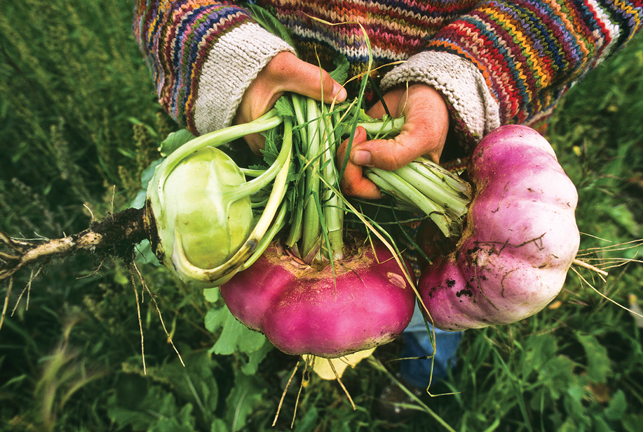
IT WAS SUPPOSED to be a hobby farm. At least, that’s what Steve Mackenzie-Grieve thought when he and his wife Bonnie purchased land 30 kilometres from downtown Whitehorse at the turn of the millennium. “You know how it goes. We got messing around and everything worked good and you kind of just keep going,” says Mackenzie-Grieve with a shrug. “There was an opportunity there and we just kept going with it.”
That opportunity was potatoes. Today, Yukon Grain Farms supplies half the potatoes eaten in the territory. The farm employs six workers, grows anywhere between 400 and 500 tonnes of potatoes each year, stores them and then sells them under the Prospector’s Pride brand at local grocery stores for nine to ten months of the year. They grow feed for local livestock too, and in recent years, they’ve expanded their operation to include carrots, cabbage and beets—increasing their winter storage capacity from 500 to 800 tonnes. This year, they’ll be adding parsnips. “We have a real business,” he says. “We make money.”
But there’s only so much hunger for their potatoes. Not all Yukoners care where their spuds come from and if potatoes imported from the south are cheaper—like when an oversupply knocks down prices across the continent—then they’ll opt for those. Prospector’s Pride potatoes are competitive when prices are normal, but Mackenzie-Grieve has to stick to a consistent price to pay fair wages to staff and maintain a profit. “Our market is the limiting factor,” he says. “Not what we can grow, or what we can store—we can build storages and we can plant more acres. But we can only sell so much stuff.”
The farm does have distinct advantages: one is obviously the short freight distance and the other is quality. “There’s something about the long days and the cool weather, it makes really sweet produce,” he says. “You know, stuff comes up the highway—sometimes it’s good, sometimes it’s not. It’s not always the same.” The company has something else going for it too—local pride. “We have the best customers in the country here,” he says. “People buy our stuff because it’s local and because it tastes good.”
The Mackenzie-Grieves are a Northern agriculture success story, just like Polar Eggs in Hay River, which ships its eggs throughout the NWT. These companies have been able to find, serve and capture a large enough segment of their market to scale up production. That’s not an easy task in the North, due simply to its unique population make-up: a few relatively larger centres and many more small, remote communities.
Whitehorse sprawls out along a windy plateau under a mountain rain shadow and isn’t nearly as good for growing as Dawson City or Mayo, yet most of the Yukon’s 140 or so farms are found near the city. A fertile market can be better for business than fertile soil. Whitehorse’s market is 27,000 people, while the Yukon’s other dozen or so communities have just 9,000 people combined. Being closer to Whitehorse—being closer to that market—makes more business sense.
And that’s the irony. The smaller, more remote communities with the highest grocery prices—the communities that would benefit most from local produce and competition— don’t necessarily have the population to support highly successful businesses.

IN QIKIQTARJUAQ, NUNAVUT, at the extreme northeast of Canada, where 10 C is considered a nice summer’s day, where trees do not grow, where the sun stays below the horizon for a month at a time, you can raise your own food. Céline Jaccard and Yves Christen have done it. They’ve just been unlucky.
The couple recently butchered their second batch of chickens, along with four quails, because they were heading out of the Baffin Island town for a month and couldn’t find anyone to look after them. Of the six chicks they hatched in their incubator, five were males. That left them with just one laying hen. Sadly, she didn’t lay any eggs.
“When we killed the female, she had an egg in preparation inside, but I think [the five males were] probably too overwhelming for her system,” says Jaccard.
Though they missed out on all those fresh breakfasts, they still wound up with meat and it didn’t cost them much at all. They built cages and water feeders with materials scavenged form the dump, they raised the birds in a heated room separate from their house, and the local Co-op gave them access to spoiled food for feed. Unlike the brazen Rankin farmers of the 1970s, who had to fly up laying mash from Manitoba, the couple reused eggshells, crushing them into powder, to feed their hen as a DIY solution. And they even gave the poultry a taste of local cuisine during hunting season. “There’s usually meat left over from the whales, so we’d pick some up and we’d feed them even with narwhal meat. As long as they get proteins and cereals and veggies, they’re pretty easy,” says Jaccard. “They eat almost anything.”
Despite the paltry yields, the experience hasn’t spoiled them on small-scale farming. If anything, it’s given them ideas on how to do it better. “If we do it again, we might go just for quails,” she says. “Because it takes five weeks for them to be ready to eat or lay eggs.”
And that might just be the ticket. Rather than jumping in headlong with hundreds of chickens and a dozen pigs and then figuring things out as you go, you start small. You learn what works and what doesn’t, and with your experience to guide you, you get more ambitious from there on out.
Northerners don’t necessarily have to grow or raise everything. People do still hunt narwhal and caribou and fish for turbot and char, albeit much less than they did 50 years ago. As much as 10 percent of the meat that ends up on a Yukon dinner plate is locally harvested—that number is likely higher in the NWT and certainly higher in Nunavut. “In some communities, that might be 50 percent,” says Yukon’s Tony Hill.
When you look at the whole picture together, with agriculture supplementing hunting and fishing, and reducing the pressures on declining game populations, the problem doesn’t seem so daunting.
Come September, Steve Mackenzie-Grieve will have 800 tonnes of potatoes, carrots, beets and cabbage in his storage. “I don’t know what people call food security,” he says. “But if the road washes out or whatever happens, there is something to eat with your moose.”

